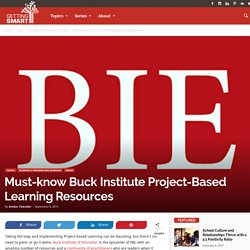

SAGE Journals: Your gateway to world-class journal research. USC - Center for Cognitive Technology. Project-Based Learning vs. Problem-Based Learning vs. X-BL. At the Buck Institute for Education (BIE), we've been keeping a list of the many types of "_____- based learning" we've run across over the years: Case-based learning Challenge-based learning Community-based learning Design-based learning Game-based learning Inquiry-based learning Land-based learning Passion-based learning Place-based learning Problem-based learning Proficiency-based learning Service-based learning Studio-based learning Team-based learning Work-based learning . . . and our new fave . . . Zombie-based learning (look it up!) Let's Try to Sort This Out The term "project learning" derives from the work of John Dewey and dates back to William Kilpatrick, who first used the term in 1918.
Designing and/or creating a tangible product, performance or event Solving a real-world problem (may be simulated or fully authentic) Investigating a topic or issue to develop an answer to an open-ended question. Making Projects Click. When is PBL More Effective? A Meta synthesis of Meta analyses Com. A Problem Based Learning Meta Analysis: Differences Across Probl. "A Problem Based Learning Meta Analysis: Differences Across Problem Ty" by Andrew Walker and Heather Leary. Abstract Problem based learning (PBL) in its most current form originated in Medical Education but has since been used in a variety of disciplines (Savery & Duffy, 1995) at a variety of educational levels (Savery, 2006).

Although recent meta analyses have been conducted (Dochy, Segers, Van den Bossche, & Gijbels, 2003; Gijbels, Dochy, Van den Bossche, & Segers, 2005) that attempted to go beyond medical education, they found only one study in economics and were unable to explain large portions of the variance across results. This work builds upon their efforts as a meta-analysis that crosses disciplines as well as categorizes the types of problems used (Jonassen, 2000), the PBL approach employed (Barrows, 1986), and the level of assessment (Gijbels et al., 2005; Sugrue, 1993, 1995).
Across 82 studies and 201 outcomes the findings favor PBL (d = 0.13, +/- .025) with a lack of homogeneity (Q = 954.27) that warrants a closer examination of moderating factors. Recommended Citation. The case for project-based learning. Gold Standard PBL: Essential Project Design Elements. Adapted from Setting the Standard for Project Based Learning: A Proven Approach to Rigorous Classroom Instruction, by John Larmer, John Mergendoller, Suzie Boss (ASCD 2015).

This post is also available as a downloadable article. It’s encouraging that Project Based Learning is becoming popular, but popularity can bring problems. Here at the Buck Institute for Education, we’re concerned that the recent upsurge of interest in PBL will lead to wide variation in the quality of project design and classroom implementation. If done well, PBL yields great results. But if PBL is not done well, two problems are likely to arise.
What is PBL? How to Make Sure That Project-based Learning is Applied Well in Schools. By Thom Markham Now that project-based learning (PBL) is becoming more popular, the doubters and haters also have surfaced.

The recent anti-PBL message by David Brooks in the New York Times, which was fortunately well rebutted, exemplifies the resistance. Citing High Tech High in San Diego, Brooks’ core message is that PBL is a kind of mindless education dressed up by technology and devoid of the ‘wisdom’ taught in traditional schools. Given that there are probably another thousand-plus schools across the country embracing PBL, this is a serious charge. And it’s false. But it should also be a warning to PBL advocates. This is no one’s fault. Why would we not settle for highly constrained problem-based PBL?
To get at the depth of purpose and engagement necessary for learners today, there’s work to do in PBL. See PBL as a mind shift, not a method. Put challenge first. Once the human mind sees a list, it’s in check-off mode. Get a lot better at Driving Questions. Coach for openness. Transforming Schools Using Project-Based Learning, Performance Assessment, and Common Core Standards – Buck Institute for Education Online Store. The world is changing and our schools are not keeping up.

In Transforming Schools Using Project-Based Learning, Performance Assessment, and Common Core Standards, BIE Executive Director Bob Lenz, along with his former colleagues Justin Wells and Sally Kingston, draw on the example of the Envision Education schools, as well as other leading schools around the country, to show how the concept of deeper learning can meet the need for students who are both college and career ready and engaged in their own education. Must-know Buck Institute Project-Based Learning Resources. Taking the leap and implementing Project-based Learning can be daunting, but there’s no need to panic or go it alone.

Buck Institute of Education is the epicenter of PBL with an amazing number of resources and a community of practitioners who are leaders when it comes to sharing ideas and projects related to PBL and spreading the word about the benefits. Here are four ways to improve your instruction that are appropriate for beginners or a great refresher for the more experienced: Make sure students are asking the right questions At the heart of Project-based Learning is the inquiry process. It is the burning question that ignites the critical thinking component of PBL, which is why formulating the question is a crucial task. Use exemplars and models as a guide Early in my career, I felt that if I were to show students examples or modeled a task for them, that I was somehow cheating them from the experience, and I also assumed that students would just copy what I showed them.